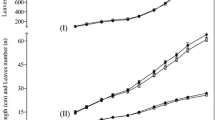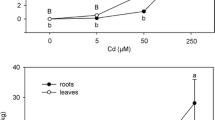Abstract
A dose–response study was performed in four commercial clones, Baldo (Populus deltoides), Jean Pourtet (Populus nigra), I-214 (Populus x euramericana) and Villafranca (Populus alba), to investigate the best performing species in terms of metal content and high metal resistance (absence of symptoms) useful in biomass production on contaminated water/land by zinc. Zinc (1 μM as control and 1 mM) was applied for 4 weeks in a hydroponic system. Clone Villafranca was the least damaged, while the most sensitive was clone I-214. The highest zinc concentration in all different parts of plants analysed was recorded in Villafranca > I-214 > Baldo > Jean Pourtet. The higher translocation factor was seen in Baldo, the lowest in Villafranca. Analyses of leaf damage showed a reduction on Chl a in young leaves (96 %) in I-214 stressed plants, whereas in Villafranca, Chl a was about double compared to the control. Regarding other photosynthetic pigments, violaxanthin was significantly correlated to zinc concentration in old leaves. The responses of clones to zinc (Zn) stress were specific: Villafranca was the most resistant, while I-214 showed the highest biomass production under Zn excess. Since these two clones have useful and complementary traits for uptake and detoxification while maintaining high biomass production under Zn excess, they are interesting candidates for understanding the key resistance mechanisms.






Similar content being viewed by others
References
Adler, A., Dimitriou, I., Aronsson, P., Verwijst, T., & Weih, M. (2008). Wood fuel quality of two Salix viminalis stands fertilized with sludge, ash and sludge–ash mixtures. Biomass & Bioenergy, 32(10), 914–925.
Arnon, D. I., & Hoagland, D. R. (1940). Crop production in artificial culture solutions and in soils with special reference to factors influencing yields and absorption of inorganic nutrients. Soil Science, 50, 463–483.
Baker, A. J. M., & Walker, P. L. (1990). Ecophysiology of metal uptake by tolerant plants: heavy metal uptake by tolerant plants. In A. J. Shaw (Ed.), Evolutionary Aspects. Boca Raton: CRC.
Broadley, M. R., White, P. J., Hammond, J. P., Zelko, I., & Lux, A. (2007). Zinc in plants. New Phytologist, 173(4), 677–702.
Castiglione, S., Todeschini, V., Franchin, C., Torrigiani, P., Gastaldi, D., Cicatelli, A., et al. (2009). Clonal differences in survival capacity, copper and zinc accumulation, and correlation with leaf polyamine levels in poplar: a large-scale field trial on heavily polluted soil. Environmental Pollution, 157(7), 2108–2117.
Covarelli, L., Beccari, G., Tosi, L., Fabre, B., & Fre, P. (2013). Three-year investigations on leaf rust of poplar cultivated for biomass production in Umbria, Central Italy. Biomass & Bioenergy, 49(2), 315–322.
Cronk, Q. C. B. (2005). Plant eco-devo: the potential of poplar as a model organism. New Phytologist, 166(1), 39–48.
de las Rivas, J., Abadía, A., & Abadía, J. (1989). A new reversed phase-HPLC method resolving all major higher plant photosynthetic pigments. Plant Physiologist, 91(1), 190–192.
Delplanque, M., Collet, S., Del Gratta, F., Schnuriger, B., Gaucher, R., Robinson, B., et al. (2013). Combustion of Salix used for phytoextraction: the fate of metals and viability of the processes. Biomass & Bioenergy, 49(2), 160–170.
Di Baccio, D., Tognetti, R., Minnocci, A., & Sebastiani, L. (2009). Responses of the Populus x euramericana clone I-214 to excess zinc: carbon assimilation, structural modifications, metal distribution and cellular localization. Environmental Experimental Botany, 67(1), 153–163.
Di Baccio, D., Minnocci, A., & Sebastiani, L. (2010). Leaf structural modifications in Populus x euramericana subjected to Zn excess. Biologia Plantarum, 54(3), 502–508.
Di Baccio, D., Galla, G., Bracci, T., Andreucci, A., Barcaccia, G., Tognetti, R., et al. (2011). Transcriptome analyses of Populus x euramericana clone I-214 leaves exposed to excess zinc. Tree Physiology, 31(12), 1293–1308.
Dickmann, D. I. (1971). Photosynthesis and respiration by developing leaves of cottonwood (Populus deltoides Bartr.). Botanical Gazette, 132, 253–259.
Disante, K. B., Fuentes, D., & Cortina, J. (2010). Sensitivity to zinc of Mediterranean woody species important for restoration. Science of the Total Environment, 408(10), 2216–2225.
Dos Santos Utmazian, M. N., Wieshammer, G., Vega, R., & Wenzel, W. W. (2007). Hydroponic screening for metal resistance and accumulation of cadmium and zinc in twenty clones of willows and poplars. Environmental Pollution, 148(1), 155–165.
European Environmental Agency (EEA). (2007a). Progress in management of contaminated sites (CSI 015). Copenhagen: European Environmental Agency.
European Environmental Agency (EEA). (2007b). Europe's Environment—The Fourth Assessment. State of the Environment Report no. 1/2007. Copenhagen: European Environmental Agency.
Evangelou, M. W. H., Deram, A., Gogos, A., Studer, B., & Schulin, R. (2012). Assessment of suitability of tree species for the production of biomass on trace element contaminated soils. Journal of Hazardous Materials, 209–210, 233–239.
Fernàndez, J., Zacchini, M., & Fleck, I. (2012). Photosynthetic and growth responses of Populus clones Eridano and I-214 submitted to elevated Zn concentrations. Journal of Geochemical Exploration, 123, 77–86.
Giachetti, G., & Sebastiani, L. (2006). Metal accumulation in poplar plant grown with industrial wastes. Chemosphere, 64(3), 446–454.
Gianquinto, G., Abu-Rayyan, A., Di Tola, L., Piccotino, D., & Pezzarossa, B. (2000). Interaction effects of phosphorous and zinc on photosynthesis, growth and yield of dwarf bean growth in two environments. Plant and Soil, 220(1–2), 219–228.
Guo, B., Liang, Y., Fua, Q., Ding, N., Liu, C., Lin, Y., et al. (2012). Cadmium stabilization with nursery stocks through transplantation: a new approach to phytoremediation. Journal of Hazardous Materials, 199–200, 233–239.
Kraemer, U. (2003). Phytoremediation to phytochelatin–plant trace metal homeostasis. New Phytologist, 158(1), 4–6.
Lingua, G., Franchin, C., Todeschini, V., Castiglione, S., Biondi, S., Burlando, B., et al. (2008). Arbuscular mycorrhizal fungi differentially affect the response to high zinc concentrations of two registered poplar clones. Environmental Pollution, 153(1), 137–147.
Mai, W. X., Tian, X. H., Gale, W. J., Yang, X., & Lu, X. C. (2011). Tolerance to Zn deficiency and P-Zn interaction in wheat seedlings cultured in chelator-buffered solutions. Journal of Arid Land, 3(3), 206–213.
Markert, B. (1992). Presence and significance of naturally occurring chemical elements of the periodic system in the plant organism and consequences for future investigations on inorganic environmental chemistry in ecosystems. Vegetatio, 103, 1–30.
Marschner, H. (1995). Mineral nutrition of higher plants (2nd ed.). London: Academic Press. 889 p.
McIvor, I. R., Douglas, G. B., & Benavides, R. (2009). Coarse root growth of Veronese poplar trees varies with position on an erodible slope in New Zealand. Agroforestry Systems, 76, 251–264.
Migeon, A., Richaud, P., Guinet, F., Blaudez, D., & Chalot, M. (2012). Hydroponic screening of poplar for trace element tolerance and accumulation. International Journal of Phytoremediation, 14(4), 350–361.
Molas, J. (2002). Changes of chloroplast ultrastructure and total chlorophyll concentration in cabbage leaves caused by excess of organic Ni(II) complex. Environmental and Experimental Botany, 47(2), 115–126.
Obernberger, I., Brunner, T., & Barnthaler, G. (2006). Chemical properties of solid biofuels—significance and impact. Biomass & Bioenergy, 30(11), 973–982.
Pilipovi, A., Nikoli, N., Orlović, S., Petrović, N., & Krstić, B. (2005). Cadmium phytoextraction potential of poplar clones (Populus spp.). Z. Naturforschung, 60(3–4), 247–251.
Potters, G., Pasternak, T. P., Guisez, Y., Palme, K. J., & Jansen, M. A. K. (2007). Stress-induced morphogenic responses: growing out of trouble? Trends in Plant Science, 12(3), 98–105.
Pulford, I. D., & Watson, C. (2003). Phytoremediation of heavy metal-contaminated land by trees—a review. Environment International, 29(4), 529–540.
Robinson, B. H., Schulin, R., Nowack, B., Roulier, S., Menon, M., Clothier, B., et al. (2006). Phytoremediation for the management of metal flux in contaminated sites. Forest Snow and Landscape Research, 80(2), 221–234.
Sagardoy, R., Morales, F., López-Millán, A. F., Abadía, A., & Abadía, J. (2009). Effects of zinc toxicity on sugar beet (Beta vulgaris L.) plants grown in hydroponics. Plant Biology, 11(3), 339–350.
Sandalio, L. M., Dalurzo, H. C., Gomez, M., Romero-Puertas, M. C., & del Rio, L. A. (2001). Cadmium-induced changes in the growth and oxidative metabolism of pea plants. The Journal of Experimental Botany, 52(364), 2115–2126.
Sebastiani, L., Scebba, F., & Tognetti, R. (2004). Heavy metal accumulation and growth responses in poplar clones Eridano (Populus deltoides x maximowiczii) and I-214 (P. x euramericana) exposed to industrial waste. Environmental and Experimental Botany, 52, 79–88.
Shah, K., & Nongkynrih, J. M. (2007). Metal hyperaccumulation and bioremediation. Biologia Plantarum, 51(4), 618–634.
Sinclair, S. A., & Krämer, U. (2012). The zinc homeostasis network of land plants. Biochimica et Biophysica Acta, 1823(9), 1553–1567.
Spinelli, R., & Hartsough, B. (2006). Harvesting SRF poplar for pulp-wood: experience in the Pacific Northwest. Biomass & Bioenergy, 30(5), 439–445.
Todeschini, V., Lingua, G., D'Agostino, G., Carniato, F., Roccotiello, E., & Berta, G. (2011). Effects of high zinc concentration on poplar leaves: a morphological and biochemical study. Environmental and Experimental Botany, 71(1), 50–56.
Watson, C., Pulford, I. D., & Riddell-Black, D. (2003). Screening of willow species for resistance to heavy metals: comparison of performance in a hydroponics system and field trials. International Journal of Phytoremediation, 5(4), 351–365.
Zacchini, M., Pietrini, F., Scarscia Mugnozza, G., Iori, V., Pietrosanti, L., & Massacci, A. (2009). Metal tolerance, accumulation and translocation in poplar and willow clones treated with cadmium in hydroponics. Water, Air, & Soil Pollution, 197(1–4), 23–34.
Acknowledgments
The authors wish to thank G. Monteforti for assistance with metal analysis and D. Di Baccio, A. Minnocci and C. Ghelardi for their help in growing the plants and performing leaf area analyses. We also thank Shannon N. Albers for language revision and critical comment to the manuscript.
Author information
Authors and Affiliations
Corresponding author
Rights and permissions
About this article
Cite this article
Romeo, S., Francini, A., Ariani, A. et al. Phytoremediation of Zn: Identify the Diverging Resistance, Uptake and Biomass Production Behaviours of Poplar Clones Under High Zinc Stress. Water Air Soil Pollut 225, 1813 (2014). https://doi.org/10.1007/s11270-013-1813-9
Received:
Accepted:
Published:
DOI: https://doi.org/10.1007/s11270-013-1813-9




